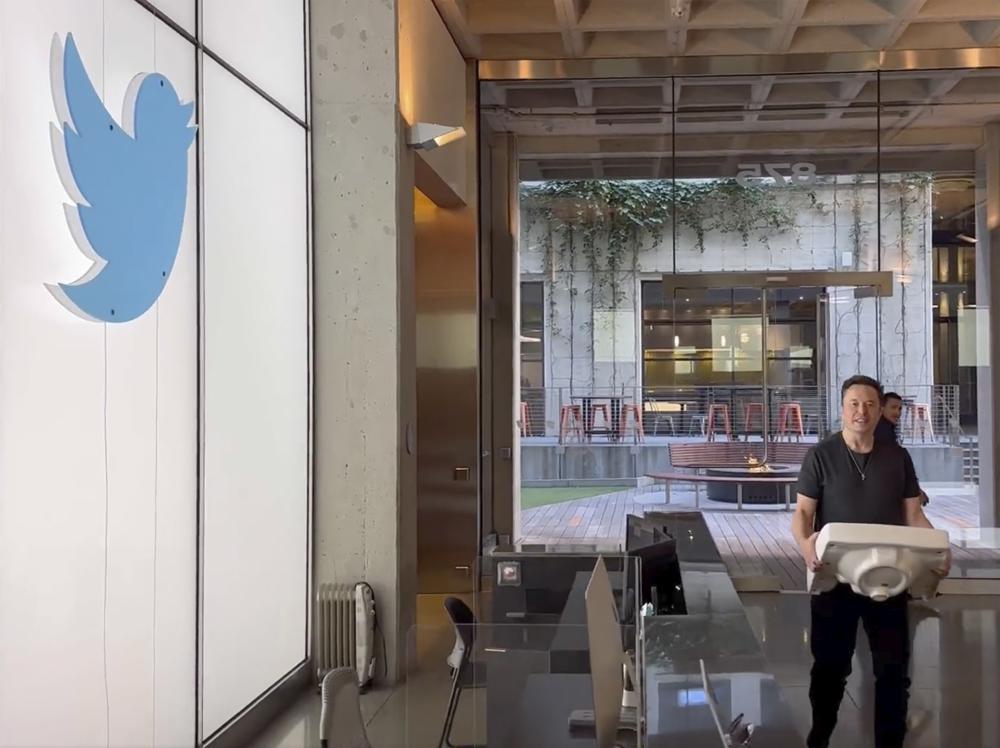Musk lugs sink into Twitter HQ as $44B deal deadline looms
SAN FRANCISCO

Elon Musk, the billionaire poised to acquire Twitter later this week, strolled into the company’s headquarters Wednesday carrying a porcelain sink and tweeting “Entering Twitter HQ - let that sink in!”
$44 billion deal to take Twitter private faces a Friday deadline, although the video he posted offered no evidence that the acquisition is complete. Twitter and Musk representatives had no comment on that question, although Twitter did confirm that Musk’s video tweet was real. Musk also changed his Twitter profile to refer to himself as “Chief Twit” and his location to Twitter’s San Francisco headquarters.
The splashy video, a vintage Musk production, also pulled the spotlight back to the world’s richest man and his on-again, off-again pursuit of the social platform.
The Friday deadline to consummate the deal was ordered by the Delaware Chancery Court in early October. It is the latest step in an epic battle during which Musk signed a deal to acquire Twitter, then tried to back out of it, leading Twitter to sue the Tesla CEO to force him to conclude the deal. If the two sides don’t meet the Friday deadline, the next step could be a November trial.
Robert Anderson, a law professor at Pepperdine University, said he fully expects the deal to close by Friday’s deadline but didn’t see much substance to Musk’s video. "I don’t see anything unusual about it, other than that he brought a sink,” he said.
Musk had been expected to visit Twitter this week and is expected to return again Friday if the deal is finalized, according to an internal memo cited in a report by Bloomberg News.
His apparent enthusiasm about visiting Twitter headquarters stood in sharp contrast to one of his earlier suggestions that the building should be turned into a “homeless shelter” because, he said, so few employees actually worked there.
The Washington Post reported last week that Musk told prospective investors that he plans to cut three quarters of Twitter’s 7,500 workers when he becomes owner of the company. The newspaper cited documents and unnamed sources familiar with the deliberation. Several hours after posting his sink video, Musk tweeted that he was meeting “a lot of cool people at Twitter today!” He gave no details.
One of Musk’s biggest obstacles to closing the deal was keeping in place the financing pledged roughly six months ago.
A group of banks, including Morgan Stanley and Bank of America, signed on earlier this year to loan $12.5 billion of the money Musk needed to buy Twitter and take it private. Solid contracts with Musk bound the banks to the financing, although changes in the economy and debt markets since April have likely made the terms less attractive. Musk even said his investment group would be buying Twitter for more than it’s worth.
Less clear is what’s happening with the billions of dollars pledged to Musk by investors who would get ownership stakes in Twitter. Musk’s original slate of equity partners included an array of partners ranging from the billionaire’s tech world friends with like-minded ideas about Twitter’s future, such as Oracle co-founder Larry Ellison, to funds controlled by Middle Eastern royalty.
The more equity investors kick in for the deal, the less Musk has to pay on his own. Most of his wealth is tied up in shares of Tesla, the electric car company that he runs. Since April, he has sold more than $15 billion worth of Tesla stock, presumably to pay his share. More sales could be coming.
Musk, 51, has shared few concrete details about his plans for the social media platform. While he’s touted free speech and derided spam bots since agreeing to buy the company in April, what he actually wants to do about either remains a mystery.
Technology analysts have speculated that Musk wants to use Twitter to help create an “everything app” similar to China’s WeChat service, which allows users to do video chats, message, stream video, scan bar codes and make payments.
Musk’s flirtation with buying Twitter appeared to begin in late March. That’s when Twitter said he contacted members of its board, including co-founder Jack Dorsey, and told them he was buying up shares and was interested in either joining the board, taking Twitter private or starting a competitor.
Then, on April 4, he revealed in a regulatory filing that he had become the company’s largest shareholder after acquiring a 9% stake worth about $3 billion.
At first, Twitter offered Musk a seat on its board. But six days later, CEO Parag Agrawal tweeted that Musk would not be joining the board after all. His bid to buy the company quickly followed.
Inside Twitter, Musk’s offer was met with confusion and falling morale, especially after Musk publicly criticized one of Twitter’s top lawyers involved in content-moderation decisions.
In July, Musk abruptly reversed course, announcing that he was abandoning his bid to buy Twitter. His stated reason: Twitter hadn’t been straightforward about its problem with fake accounts he dubbed “spam bots.” Twitter sued, and two weeks before a 5-day trial was scheduled to begin, Musk changed his mind again, saying that he wanted to complete the deal after all.
















